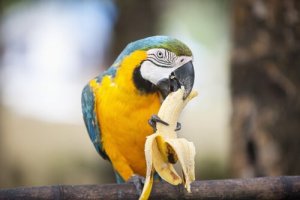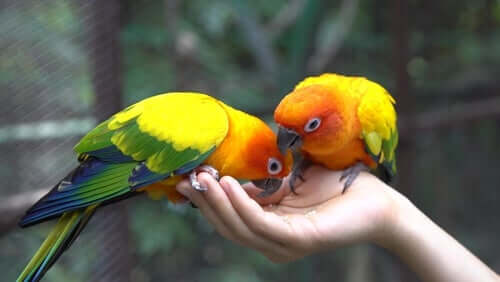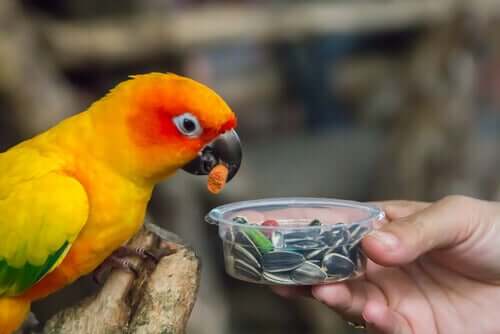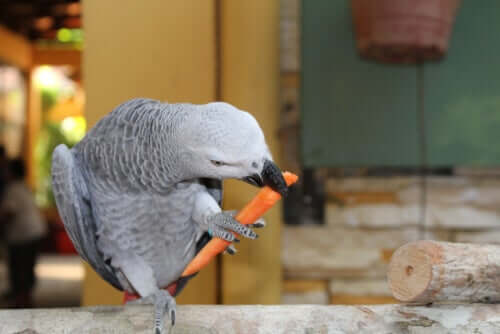Parrot Diet and Nutrition - Facts and Tips


Written and verified by the biologist Ana Díaz Maqueda
A parrot diet is one of the few things you can control to keep yours healthy. However, you must really pay attention to what you add to it in order and make sure it promotes their well-being. This is because feeding them poor quality junk food will only lead to problems in their normal development. Also, it’ll result in diseases and even weird behavior.
For this reason, a proper diet should be balanced and provide all the necessary nutrients according to the animal’s species, age, and activity. So, today we’re going to tell you what kind of food should be in your parrot diet.
Parrot diet and nutrition

Extruded feed is one of the options for a parrot diet as it’s specifically designed for this species. There’s a wide variety of feed out there on the market; they come in different types so you can choose the one that best suits you. As with all prepacked food products, you must look at the ingredients listed on the labels.
Processed pet food is a simple, convenient, and easy way to feed your parrot. However, they must be used to eating it since they’re very young. They tend to reject it otherwise and could even stop eating altogether. Just like with all new foods, you must introduce it gradually into their diet.
So, if you decide to give this type of diet to your parrot, then you’ll also need to add an extra in the form of fresh vegetables and fruits.
Parrot diet – real food
If, on the other hand, you’d rather design a parrot diet in a way that’s similar to what they would eat in their natural environment, you’ll just have to be aware of its components. Parrots need two feeders available, one for fruit and vegetables, and the other one for cereals and seeds.
The cereals and seeds should comprise 50% of the food, vegetables 45%, and fruit 2.5%. For the remaining 2.5% use food supplements such as nuts of all sorts, calcium in the form of cuttlefish bones or calcium blocks for parrots, and grit (small stones that help them digest the seeds). Keep in mind there are some toxic food items you should never feed parrots.
Cereals and seeds

You can make a mix of packaged seeds for psittacine birds, with a minimum of sunflower seeds. Or, you can buy it all in bulk and then make a custom mixture which should contain:
- Millet
- Hulled oatmeal
- Birdseed
- Turnip seeds
- In general, sunflower seeds are very poor in vitamins and minerals and contain too much fat and protein. Still, parrots love them so give them some. Just limit their quantity even if your bird stops eating or throws away the rest of the food.
Vegetables

In general, any vegetables you use must be fresh, clean and cut. There’s a wide variety of vegetables you can feed your parrot as long as you add them slowly to their diet. This is so you can identify which ones they like the most:
- Spinach
- Endives
- Carrots
- Pumpkin
- Green peas
- Boiled potatoes
- Green beans
- Lentils (hydrated)
- Chickpeas (hydrated)
- Broccoli
- Artichokes
- Cauliflower
- Tomatoes
- Green, red, yellow and orange peppers
- Chard
- Radishes
- Celery
Fruit
You should also give them a minimum of three different types of fruit. In addition, you must clean and chop them every day:
- Apples
- Pears
- Tangerines
- Oranges
- Apricots
- Blueberries
- Strawberries
- Grapefruits
- Watermelon
- Kiwis
- Pineapple
- Papaya
- Persimmons
- Grenades
- Mangoes
- Cherries
- Grapes
- Cantaloupe
- Bananas
- Peaches
- Loquats
Frequent mistakes people make in parrot diets
Occasionally, people make mistakes when feeding their parrot and the birds reject the food. These are the most common mistakes:
- The food bowl is dirty. In general, and contrary to what you might believe, most animals dislike eating from dirty bowls. So, just like you maintain good hygiene in their cage, you must also keep their feeder clean at all times. That is, free of old food and droppings.
- Don’t leave the same food for more than one day as it’ll stop being tasty in the eyes of the parrot. In addition, food spoils quite fast and becomes rancid and stale.
- Some parrots eat seeds only. However, a diet based exclusively on them isn’t healthy. It’ll be a challenge, but you must help them learn to eat other things.
- Finally, parrots usually leave the husks of their seeds in the bowl and it may seem like it’s full. So, you must remove the husks and refill the feeder with seeds every day.
We hope you’ve enjoyed this article.
https://misanimales.com/alimentos-puedo-darle-loro/
A parrot diet is one of the few things you can control to keep yours healthy. However, you must really pay attention to what you add to it in order and make sure it promotes their well-being. This is because feeding them poor quality junk food will only lead to problems in their normal development. Also, it’ll result in diseases and even weird behavior.
For this reason, a proper diet should be balanced and provide all the necessary nutrients according to the animal’s species, age, and activity. So, today we’re going to tell you what kind of food should be in your parrot diet.
Parrot diet and nutrition

Extruded feed is one of the options for a parrot diet as it’s specifically designed for this species. There’s a wide variety of feed out there on the market; they come in different types so you can choose the one that best suits you. As with all prepacked food products, you must look at the ingredients listed on the labels.
Processed pet food is a simple, convenient, and easy way to feed your parrot. However, they must be used to eating it since they’re very young. They tend to reject it otherwise and could even stop eating altogether. Just like with all new foods, you must introduce it gradually into their diet.
So, if you decide to give this type of diet to your parrot, then you’ll also need to add an extra in the form of fresh vegetables and fruits.
Parrot diet – real food
If, on the other hand, you’d rather design a parrot diet in a way that’s similar to what they would eat in their natural environment, you’ll just have to be aware of its components. Parrots need two feeders available, one for fruit and vegetables, and the other one for cereals and seeds.
The cereals and seeds should comprise 50% of the food, vegetables 45%, and fruit 2.5%. For the remaining 2.5% use food supplements such as nuts of all sorts, calcium in the form of cuttlefish bones or calcium blocks for parrots, and grit (small stones that help them digest the seeds). Keep in mind there are some toxic food items you should never feed parrots.
Cereals and seeds

You can make a mix of packaged seeds for psittacine birds, with a minimum of sunflower seeds. Or, you can buy it all in bulk and then make a custom mixture which should contain:
- Millet
- Hulled oatmeal
- Birdseed
- Turnip seeds
- In general, sunflower seeds are very poor in vitamins and minerals and contain too much fat and protein. Still, parrots love them so give them some. Just limit their quantity even if your bird stops eating or throws away the rest of the food.
Vegetables

In general, any vegetables you use must be fresh, clean and cut. There’s a wide variety of vegetables you can feed your parrot as long as you add them slowly to their diet. This is so you can identify which ones they like the most:
- Spinach
- Endives
- Carrots
- Pumpkin
- Green peas
- Boiled potatoes
- Green beans
- Lentils (hydrated)
- Chickpeas (hydrated)
- Broccoli
- Artichokes
- Cauliflower
- Tomatoes
- Green, red, yellow and orange peppers
- Chard
- Radishes
- Celery
Fruit
You should also give them a minimum of three different types of fruit. In addition, you must clean and chop them every day:
- Apples
- Pears
- Tangerines
- Oranges
- Apricots
- Blueberries
- Strawberries
- Grapefruits
- Watermelon
- Kiwis
- Pineapple
- Papaya
- Persimmons
- Grenades
- Mangoes
- Cherries
- Grapes
- Cantaloupe
- Bananas
- Peaches
- Loquats
Frequent mistakes people make in parrot diets
Occasionally, people make mistakes when feeding their parrot and the birds reject the food. These are the most common mistakes:
- The food bowl is dirty. In general, and contrary to what you might believe, most animals dislike eating from dirty bowls. So, just like you maintain good hygiene in their cage, you must also keep their feeder clean at all times. That is, free of old food and droppings.
- Don’t leave the same food for more than one day as it’ll stop being tasty in the eyes of the parrot. In addition, food spoils quite fast and becomes rancid and stale.
- Some parrots eat seeds only. However, a diet based exclusively on them isn’t healthy. It’ll be a challenge, but you must help them learn to eat other things.
- Finally, parrots usually leave the husks of their seeds in the bowl and it may seem like it’s full. So, you must remove the husks and refill the feeder with seeds every day.
We hope you’ve enjoyed this article.
https://misanimales.com/alimentos-puedo-darle-loro/
All cited sources were thoroughly reviewed by our team to ensure their quality, reliability, currency, and validity. The bibliography of this article was considered reliable and of academic or scientific accuracy.
- Brightsmith, D. J. (2012). Nutritional levels of diets fed to captive Amazon parrots: does mixing seed, produce, and pellets provide a healthy diet? Journal of Avian Medicine and Surgery, 26(3), 149–160. https://bioone.org/journals/journal-of-avian-medicine-and-surgery/volume-26/issue-3/2011-025R.1/Nutritional-Levels-of-Diets-Fed-to-Captive-Amazon-Parrots/10.1647/2011-025R.1.short
- Hernandez-Calva, L. M., Cortes-Roldan, P., Montalvo-Aguilar, X. G., Villalobos-Peñalosa, P., Galaviz-Rodriguez, J. R., & Hernández-Velasco, J. A. (2021). Evaluation of the consumption of two integral diets for psittacines in captivity in a wildlife rescue unit. Agro Productividad, 14(1), 95-99. https://www.revista-agroproductividad.org/index.php/agroproductividad/article/view/1796
- Kalmar, I. D., Janssens, G. P., & Moons, C. P. (2010). Guidelines and ethical considerations for housing and management of psittacine birds used in research. ILAR journal, 51(4), 409–423. https://pubmed.ncbi.nlm.nih.gov/21131717/
- Matson, K. D, & Koutsos, E. A. (2006). Captive Parrot Nutrition: Interactions with Anatomy, Physiology, and Behavior. En A. Luescher (Ed) Captive parrot welfare. Manual of parrot behavior (pp.49 – 58). https://onlinelibrary.wiley.com/doi/10.1002/9780470344651.ch6
- Pryor, G. S. (2003). Protein requirements of three species of parrots with distinct dietary specializations. Zoo biology, 22(2), 163–177. https://onlinelibrary.wiley.com/doi/10.1002/zoo.10086
This text is provided for informational purposes only and does not replace consultation with a professional. If in doubt, consult your specialist.








